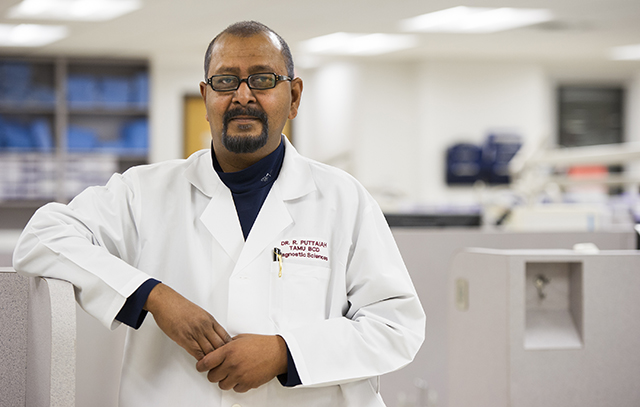TAMBCD professor’s audience on infection control expands to anaplastology, International College of Dentists

For more than 20 years, Dr. Raghunath Puttaiah has made infection control his life’s work, sharing specially designed protocols and training programs with students at Texas A&M University Baylor College of Dentistry and with dental schools and governments around the globe. Puttaiah immersed himself in the subject during a postdoctoral fellowship in infectious disease control at the UT San Antonio dental school in the early ’90s, just after the height of the HIV and AIDs epidemic.
As airborne viruses like influenza run rampant and global scares involving saliva- and blood-borne pathogens such as Ebola continue to dominate headlines, the need for proper infection control standards becomes more obvious than ever.
On Feb. 3, Puttaiah, an associate professor in diagnosis sciences at TAMBCD who teaches several hours of infection control instruction to second-year dental and graduate students, shared more on the philosophies behind these standards during an after-hours seminar.
In early 2015, his infection control training programs were translated to another discipline: anaplastology, the art and science of restoring missing or malformed parts of the body through artificial means. He collaborated with TAMBCD anaplastologist Suzanne Verma to set up a fully responsive, three-module training program for the International Anaplastology Association, with an interactive webinar that aired Jan. 14. The program is the first of its kind for the association’s membership.
As of fall 2014, the International College of Dentists adopted Puttaiah’s online infection control and occupational safety training programs through video streaming, allowing for any of the honorary society’s 12,000 members to receive this instruction with the click of a mouse.
Puttaiah, a fellow of the ICD, explains that the modules provide total access to this cutting-edge training, free of charge.
“Things like SARS, Ebola; every time we think we have achieved something, there is a curveball or a knuckleball that hits us in the face. The least we can do is give access to information that can be regularly used in clinics.”
The collaborations build upon years of work in several countries, including India, where Puttaiah helped write the infection control standards. More recently, he has worked with Russian health officials, helping them to identify their country’s dental infection control problem areas and potential standards to address them.
For Puttaiah, the recent strides bring him a step closer to achieving an overarching career objective.
“My end goal,” he says, “is to make an infection control and occupational safety curriculum at every dental school in the world.”